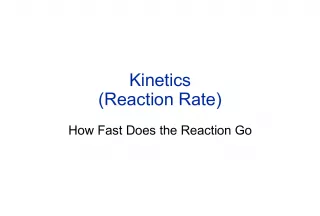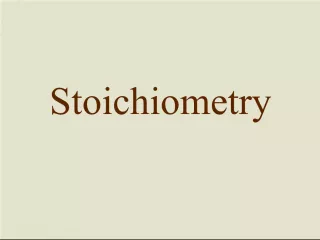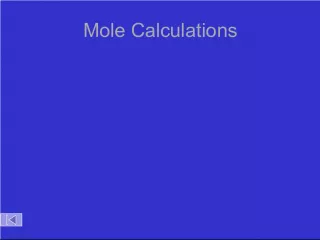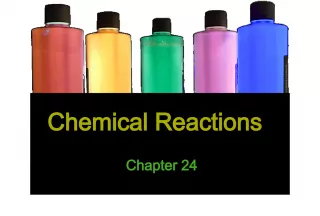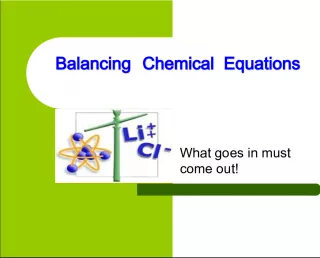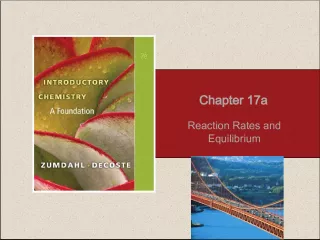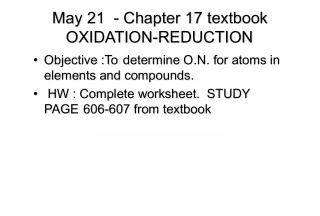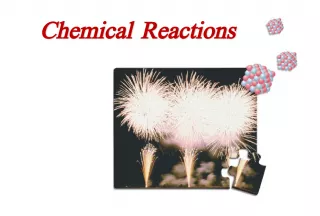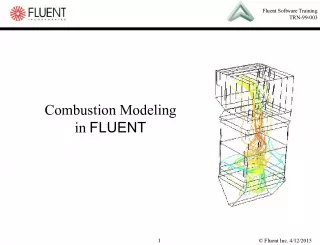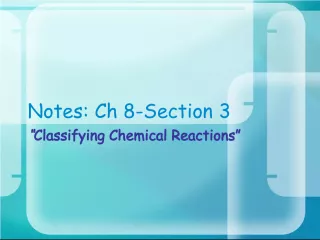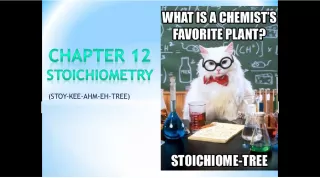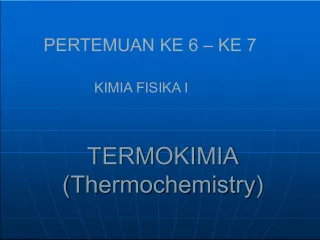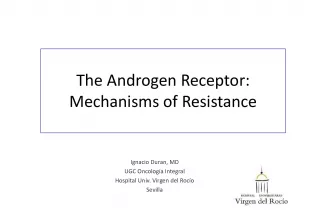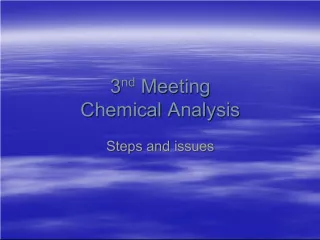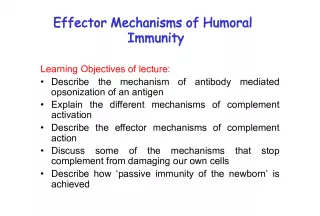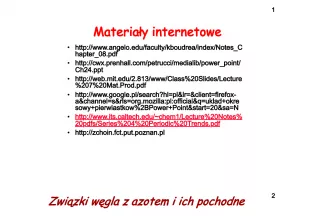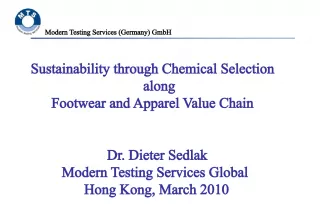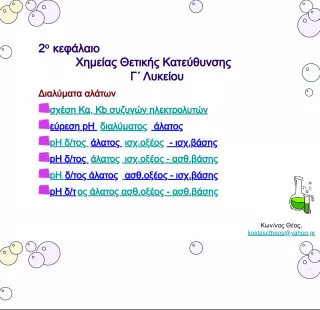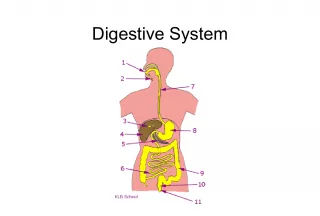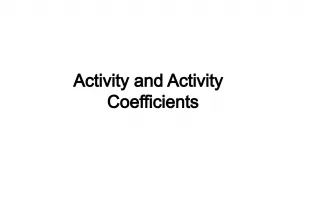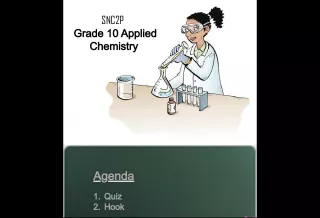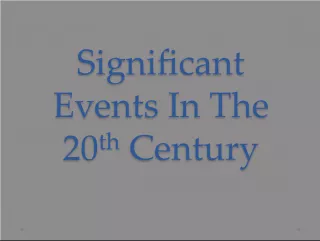Understanding Chemical Reaction Kinetics and Mechanisms
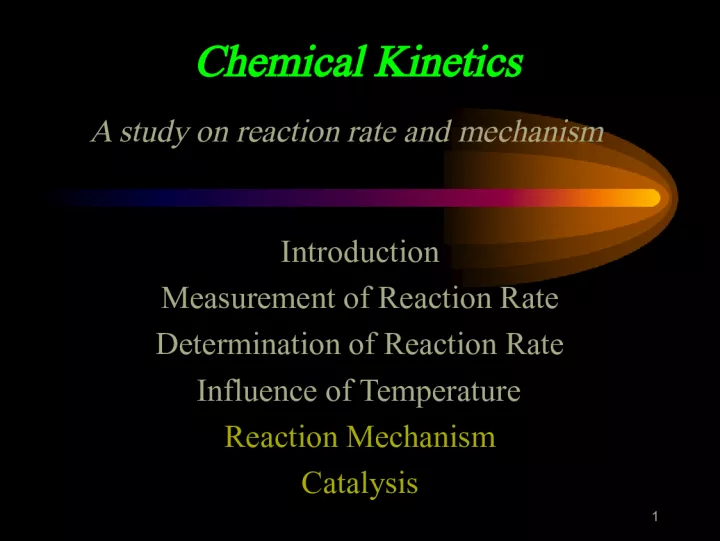

This article discusses the importance of measuring and determining reaction rates, the influence of temperature, and the role of catalysis in chemical kinetics. Additionally, we explore the concept of reaction mechanisms and how they provide a detailed picture of chemical reactions.
- Uploaded on | 0 Views
-
 eliya
eliya
About Understanding Chemical Reaction Kinetics and Mechanisms
PowerPoint presentation about 'Understanding Chemical Reaction Kinetics and Mechanisms'. This presentation describes the topic on This article discusses the importance of measuring and determining reaction rates, the influence of temperature, and the role of catalysis in chemical kinetics. Additionally, we explore the concept of reaction mechanisms and how they provide a detailed picture of chemical reactions.. The key topics included in this slideshow are Chemical kinetics, reaction rate, temperature, catalysis, reaction mechanism,. Download this presentation absolutely free.
Presentation Transcript
1. 1 Chemical Kinetics Introduction Measurement of Reaction Rate Determination of Reaction Rate Influence of Temperature Reaction Mechanism Catalysis A study on reaction rate and mechanism
2. 2 The balanced (overall) chemical equation provides information about the initial reactants and final products, i.e., the beginning and end of a reaction. The reaction mechanism gives the path of the reaction. Mechanisms provide a very detailed picture of which bonds are broken and formed during the course of a reaction. Reaction Mechanisms Reaction Mechanisms
3. Reaction Mechanisms A series of (hypothetic) reaction taken place in a chemical process The kinetics (rate law) provide a hint on the mechanism
4. 4 Mechanisms and rates Setiap tahap elementer memiliki nilai energi aktivasi Energi aktivasi menentukan nilai k. k = Ae - (E a /RT) k menentukan laju reaksi Tahap paling lambat memiliki energi aktivasi terbesar
5. 5 + Reaksi ini berlangsung melalui 3 tahap K o o r d I n a t r e a k s i Energoi Potensial
6. 6 + E a Tahap pertama berlangsung cepat Energi aktivasi rendah K o o r d i n a t r e a k s i Energoi Potensial
7. 7 Tahap kedua berlangsung lambat Energi aktivasi tinggi + E a K o o r d i n a t r e a k s i Energoi Potensial
8. 8 + E a Tahap ketiga cepat Energi aktivasi rendah K o o r d i n a t r e a k s i Energoi Potensial
9. 9 Tahap kedua merupakan tahap penentu laju K o o r d i n a t r e a k s i Energoi Potensial
10. 10 Keadaan yang menggambarkan adanya intermediate K o o r d i n a t r e a k s i Energoi Potensial
11. 11 Kompleks teraktivasi atau Keadaan transisi K o o r d I n a t r e a k s i Energoi Potensial
12. 12 Elementary Steps An elementary step is any reaction that occurs as a result of a single molecular collision . Molecularity: the number of molecules involved in an elementary step. Unimolecular: one molecule in the elementary step, Bimolecular: two molecules in the elementary step, and Termolecular: three molecules in the elementary step. It is not common to see termolecular processes (statistically improbable). Reaction Mechanisms Reaction Mechanisms
13. 13 Multistep Mechanisms Some reactions proceed through more than one step: NO 2 ( g ) + NO 2 ( g ) NO 3 ( g ) + NO( g ) NO 3 ( g ) + CO( g ) NO 2 ( g ) + CO 2 ( g ) Notice that if we add the above steps, we get the overall reaction: NO 2 ( g ) + CO( g ) NO( g ) + CO 2 ( g ) This reaction is said to take place via a two-step mechanism. Reaction Mechanisms Reaction Mechanisms
14. 14 Multistep Mechanisms If a reaction proceeds via several elementary steps, then the elementary steps must add to give the balanced chemical equation. Reaction Mechanisms Reaction Mechanisms
15. 15 Multistep Mechanisms NO 2 ( g ) + NO 2 ( g ) NO 3 ( g ) + NO( g ) NO 3 ( g ) + CO( g ) NO 2 ( g ) + CO 2 ( g ) sum to give the overall reaction: NO 2 ( g ) + CO( g ) NO( g ) + CO 2 ( g ) Notice that the reactive intermediate is formed in the first step and is consumed in the second step. Reaction Mechanisms Reaction Mechanisms
16. 16 Reactive intermediates Reactive intermediate: a species which appears in an elementary step but which is not a reactant or product in the overall reaction. Example: NO 3 in the previous example Usually a rather unfamiliar and unstable species Reaction Mechanisms Reaction Mechanisms
17. 17 PE diagram for a reaction with a two-step mechanism Reaction Mechanisms Reaction Mechanisms NO 2 + CO NO 3 NO + CO 2 Transition states/ activated complexes Reactive intermediate Reaction pathway Potential energy
18. 18 Rate Laws for Elementary Steps The rate law for an elementary step is determined by its molecularity: Unimolecular elementary reactions have a first order rate law, Bimolecular elementary reactions have a second order rate law, and Termolecular elementary reactions have a third order rate law. Reaction Mechanisms Reaction Mechanisms
19. 19 Rate Laws for Elementary Steps Reaction Mechanisms Reaction Mechanisms
20. 2NO 2 + F 2 2NO 2 F r = k[NO 2 ][F 2 ] (Empiric) Proposed mechanism: NO 2 + F 2 NO 2 F + F F + NO 2 NO 2 F F dinamakan intermediet. It is formed then consumed in the reaction Reaction Mechanisms Lambat Cepat
21. 21 The various elementary steps in the mechanism of a reaction proceed at different rates The slowest step in the reaction mechanism is called the rate-determining step or the rate-limiting step in the reaction mechanism. Ex. It has been established experimentally that the rate law for the reaction NO 2 (g) + CO(g) = NO(g) + CO 2 (g) is r = k[NO 2 ] 2 . Propose 2-step mechanism for this reaction !!! Rate-determining step Rate-determining step
22. 22 Rate-determining step Rate-determining step Step 1 is much slower than step 2 k 1 << k 2 , i.e., then step 1 will be the rate-determining step. r 1 = k 1 [NO 2 ] 2 . Since step 1 is the rate-determining step, we can say that, for the overall reaction r = k 1 [NO 2 ] 2 .
23. 23 Formulating a Mechanism The overall reaction 2 NO + O 2 2 NO 2 has been found empirically to be 2nd-order in NO and 1st order in O 2 . What could be the mechanism? Mekanisme yang mungkin:
24. 24 Formulating a Mechanism Dari mekanisme reaksi: Hukum laju ini masih mengandung intermediate: An acceptable rate law for an overall reaction is expressed solely in terms of the species that appear in the overall reaction Not acceptable !!!!!! Untuk menghilangkan [N 2 O 2 ] dari ungkapan hk laju digunakan pendekatan steady-state. Menurut pendekatan ini
25. 25 Solution Using S-S Approx.. The concentration of intermediate is assumed to remain small and hardly change during much of the reaction.
26. 26 Formulating a Mechanism
27. 27 Formulating a Mechanism Jika k 2 >>> k 3 Hukum laju empirik terpenuhi jika k 2 >>> k 3
28. 28 Another Rate-Determining Step Untuk reaksi dan mechanisme yang sama, dan O 2 jumlahnya sedikit:: Reaksi 3 sekarang menjadi tahap penentu laju. Karena O 2 jumlahnya terbatas, maka N 2 O 2 yang terbentuk menjadi sukar untuk bereaksi dengan O 2 . Karena itu hukum laju harus diturunkan dari reaksi 3:
29. 29 Another Rate-Determining Step Tetapi N 2 O 2 harus dieliminasi dari persamaan Hk. Laju. Jika reaksi 1 dan 2 mencapai keadaan setimbang: maka k a [NO] 2 = k a [N 2 O 2 ] Atau k = 2k3K
30. 30 Rate-Determining Step Consider again the oxidation of NO by the first proposed mechanism. Jika O 2 dalam keadaan berlebih dan reaksi 3 berlangsung cepat, so that k 3 [O 2 ] k 2 N 2 O 2 bereaksi sangat cepat sehingga sesaat setelah terbentuk langsung bereaksi dg O 2 .
31. 31 Rate-Determining Step The overall rate of the reaction is therefore determined by the rate of forming N 2 O 2 . Formation of N 2 O 2 is the rate-determining step / tahap penentu laju Laju reaksinya menjadi: r = 2 k 1 [NO] 2
32. 32 Exercise E7.12 An alternative mechanism that may apply when the concentration of O 2 is high and that of NO is low is one in which: Diikuti oleh: Turunkan bahwa hukum lajunya sesuai dengan pengamatan empiris
33. 33 Exercise E7.12 Dekomposisi ozon menjadi oksigen berlangsung melalui mekanisme sbg berikut: Turunkan ungkapan hukum laju untuk d[O3]/dt Pada kondisi apakah reaksi ini merupakan orde 1 terhadap O3?, tunjukan bagaimana hukum laju pada jawaban a dapat direduksi untuk hal tersebut.
34. 34 Minggu Depan Pelajari kinetika (Ungkapan hukum lajunya) - Reaksi berantai - Reaksi bercabang
